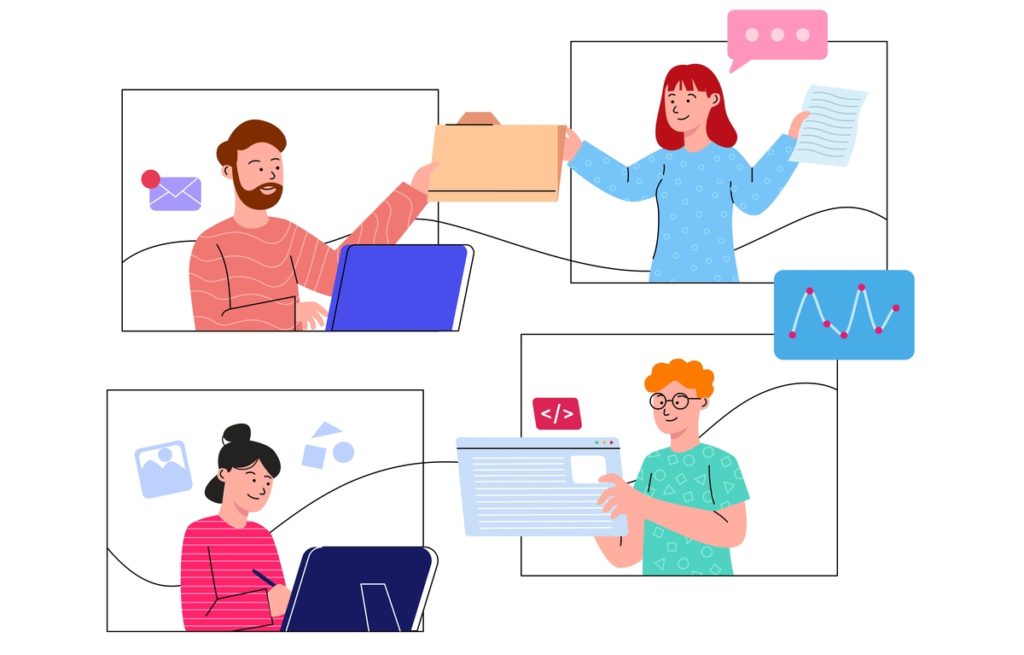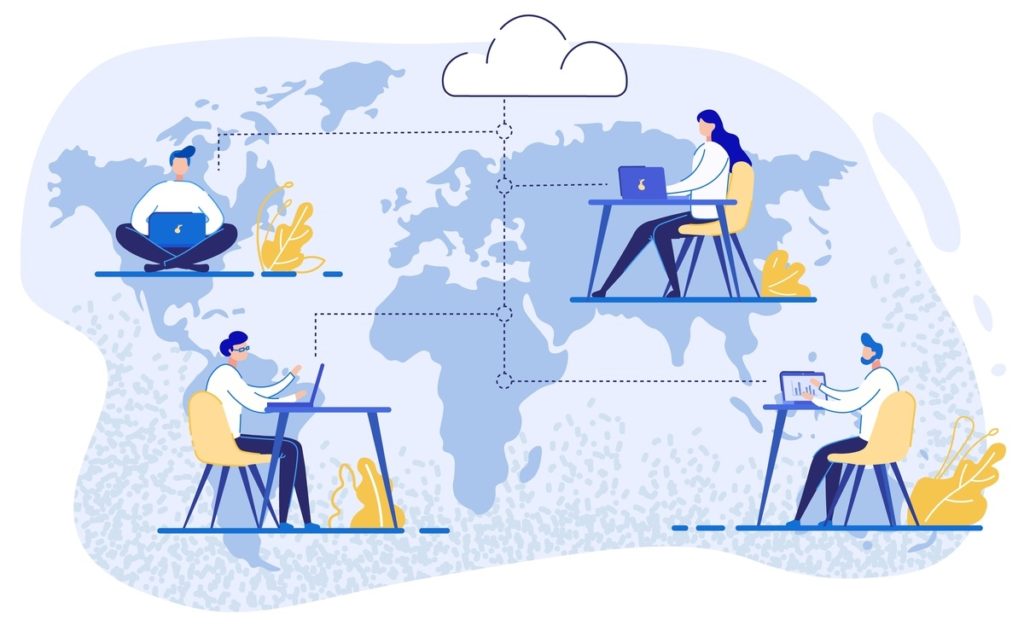Design in a remote world
| English | Polish |
|---|---|
Creativity and collaboration have long been colored by iconic images evoking a high degree of physicality—the team huddled together in a messy studio space, collaborating with expressive gestures and visual props, like sticky notes or whiteboards. The air is electric, the ideas fly, and the flow unstoppable. It’s a deeply appealing image, even aspirational, touching on core aspects of the human condition—the desire to connect and create. | Kreatywność i współpraca od dawna są ilustrowane przez ikoniczne obrazy przywołujące wysoki stopień fizyczności – zespół ściśnięty w zabałaganionej, studyjnej przestrzeni, współpracujący przy pomocy ekspresyjnych gestów i wizualnych rekwizytów, jak samoprzylepne karteczki czy tablice. Elektryzująca atmosfera, latające pomysły, nieustanny przepływ myśli. To głęboko sugestywny obraz, nawet pożądany, dotykający podstawowych aspektów ludzkiej natury – pragnienia więzi i tworzenia. |
For designers, the pull of this image can make the transition to remote work jarring at first. Much of the user experience we associate with creativity and collaboration are now different in a distributed environment. The good news is that neither creativity nor collaboration are weakened by distance — merely altered. And the conditions that make them possible remain the same. | Urok tego obrazu może sprawić, że przejście do pracy zdalnej będzie na początku szokujące dla projektantów. Duża część wrażeń użytkownika, które kojarzą nam się z kreatywnością i współpracą, jest teraz inna w rozproszonym środowisku. Dobra wiadomość jest taka, że odległość nie wpływa negatywnie na kreatywność ani współpracę – tylko je zmienia. A warunki, które je umożliwiają, pozostają takie same. |
Successful collaboration still depends on trust, psychological safety, and the open exchange of diverse ideas, perspectives, and expertise. Similarly, the creative process doesn’t recognize the boundaries of a studio space or office building. It still involves the same age-old cycle of research, ideation, prototyping, testing, and iteration. The difference is that it requires new tools to replicate certain activities in a digital environment. | Skuteczna współpraca nadal zależy od zaufania, psychologicznego bezpieczeństwa oraz otwartej wymiany różnych pomysłów, punktów widzenia i wiedzy fachowej. Podobnie proces twórczy nie uznaje granic przestrzeni studyjnej czy biurowej. Wciąż obejmuje ten sam odwieczny cykl badań, generowania pomysłów, prototypowania, testowania i iteracji. Różnica polega na tym, że wymaga on nowych narzędzi do powielania pewnych działań w środowisku cyfrowym. |
But while remote work doesn’t change the fundamental nature of creativity or collaboration, it does more quickly amplify flaws in culture, process, or leadership that already exist. “The physicality of us being together in the same space can be a cheat sheet,” says Stephen Gates, head design evangelist at InVision. “What remote work does is show a lot of your organizational sins if you haven’t been doing the right thing.” | O ile praca zdalna nie zmienia fundamentalnej natury kreatywności czy współpracy, o tyle szybciej potęguje istniejące wady kultury, procesów czy przywództwa. „Fizyczność tego, że jesteśmy razem w tej samej przestrzeni, może działać jak katalizator” – mówi Stephen Gates, główny propagator projektowania w InVision. „Praca na odległość pokazuje wiele grzechów organizacyjnych, jeśli nie robi się tego, co trzeba.” |
Teams that lack trust or psychological safety will need to be more deliberate about building relationships and creating safe space for collaboration. Silos that may have been softened by co-location will concretize in a remote environment unless teams are proactive about being inclusive. And teams that previously navigated the product creation lifecycle by happenstance will discover the need to define and advocate for a shared creative process more explicitly. | Zespoły, którym brakuje zaufania lub psychologicznego bezpieczeństwa, będą musiały bardziej świadomie budować relacje i tworzyć bezpieczną przestrzeń do współpracy. Izolowanie się, które mogło zostać złagodzone przez wspólne wykorzystanie przestrzeni, będzie się nasilać w zdalnych środowiskach, chyba że zespoły będą proaktywne w kwestii integracji. Zespoły, które wcześniej poruszały się po cyklu tworzenia produktu w sposób przypadkowy, odkryją potrzebę wyraźniejszego zdefiniowania i wspierania wspólnego procesu twórczego. |
In this sense, the transition to remote work isn’t just a challenge to be solved — it’s an opportunity to improve. Remote work can help strip away the cover and camouflage of problems that were previously concealed in an office environment. The teams that take the time and energy to address these problems will emerge all the better for it, and discover a host of additional benefits besides. | W tym sensie przejście do pracy zdalnej jest nie tylko zadaniem do rozwiązania – jest okazją do poprawy. Praca zdalna może pomóc w ujawnieniu problemów, które wcześniej były ukryte w środowisku biurowym. Zespoły, które poświęcą czas i energię na rozwiązanie tych problemów, wiele na tym zyskają i odkryją mnóstwo dodatkowych korzyści. |

Right people, right tools
| English | Polish |
|---|---|
Critical to success is ensuring you have the right people working to solve problems together. Traditionally this meant designers working alongside developers and product managers. But we need to look beyond this core group and be more inclusive; we need more roles to bring their hard-earned perspective to the experience creation process. Take a look at the end-to-end customer experience and document all of the parts of the business that help to make that happen, from marketing executives near the beginning of the experience, to the day-to-day use which likely involve customer success managers and different levels of customer support. | Decydujące znaczenie dla sukcesu ma zapewnienie sobie odpowiednich osób wspólnie pracujących nad rozwiązywaniem problemów. Tradycyjnie oznaczało to współpracę projektantów z programistami i menedżerami produktów. Musimy jednak spojrzeć poza tę podstawową grupę i być bardziej otwarci; potrzebujemy więcej różnych specjalistów, aby wykorzystać ich cenne doświadczenie w procesie tworzenia wrażeń. Przyjrzyjmy się kompleksowemu wrażeniu klientów i udokumentujmy wszystkie elementy, które je wywołują, począwszy od menedżerów ds. marketingu, a skończywszy na codziennym użytkowaniu, w którym prawdopodobnie uczestniczą menedżerowie ds. zadowolenia klientów i różnych poziomów obsługi klienta. |
When we work remotely our day is typically filled using applications to connect and collaborate (e.g., Zoom, Freehand, Slack, Google Docs). And it begins to feel like everything we do needs a tool in the form of another application. I’m here to remind you that is not the case for design! We have a powerful toolkit that enables us to understand people, validate the problem(s) to solve, find needs to fill, and create innovative solutions that customers want to use. Your most powerful tools don’t require software; they require people. | Kiedy pracujemy zdalnie, nasz dzień jest zazwyczaj wypełniony korzystaniem z komunikatorów i aplikacji do współpracy (np. Zoom, Freehand, Slack, Google Docs). Zaczyna odnosić się wrażenie, że wszystko, co robimy, wymaga narzędzia w postaci innej aplikacji. Jestem tu po to, aby wam przypomnieć, że tak nie jest w przypadku projektowania! Mamy potężny zestaw narzędzi, który pozwala nam zrozumieć ludzi, zweryfikować problem(y) do rozwiązania, znaleźć potrzeby do zaspokojenia i stworzyć innowacyjne rozwiązania, których klienci chcą używać. Twoje najpotężniejsze narzędzia nie wymagają oprogramowania, wymagają ludzi. |
Design thinking should always be your primary toolkit, working remotely or not. And you should know all of your stakeholders’ “voices” to create the right, user-centered experiences. Get to know these folks and invite them into your team to hang out. Don’t know who these people are? Go find them! Don’t wait for them to find you. You’re the designer. Stay curious! | Myślenie projektowe powinno być zawsze podstawowym narzędziem, bez względu na to, czy pracujemy zdalnie czy nie. A ty powinieneś poznać głosy wszystkich swoich interesariuszy, aby stworzyć właściwe, skoncentrowane na użytkowniku wrażenia. Poznaj tych ludzi i zaproś ich do swojego zespołu, aby spędzić z nimi czas. Nie wiesz, kim są ci ludzie? Idź i znajdź ich! Nie czekaj, aż oni cię znajdą. Jesteś projektantem. Pozostań ciekawy! |
Lastly, do what you can to make sure everyone has access to the same tools and information. Few things are as challenging as not knowing what you don’t know that you don’t know because in the remote workplace it’s difficult to stumble upon answers to questions that you don’t know to ask. | Ostatnia sprawa – zrób co możesz, aby wszyscy mieli dostęp do tych samych narzędzi i informacji. Istnieje niewiele rzeczy równie trudnych, co brak wiedzy o tym, czego nie wiesz, ponieważ w zdalnym miejscu pracy trudno jest natknąć się na odpowiedzi na pytania, których nie zadasz. |
All of this will help you promote and foster a creative work environment beyond the virtual borders of design. Share your knowledge and be an open book. The secret sauce is never in the what or the how, but the who. If you are known as the person who brings everyone together to solve problems, then you may have ninety-nine problems — but working remotely won’t be one. | Wszystko to pomoże wam promować i wspierać kreatywne środowisko pracy wykraczające poza wirtualne granice projektowania. Podzielcie się swoją wiedzą i bądźcie otwartą księgą. Sekretnym składnikiem nigdy nie jest co lub jak, ale kto. Jeśli jesteś osobą, która zajmuje się tworzeniem zespołów do rozwiązywania problemów, możesz mieć dziewięćdziesiąt dziewięć problemów – ale praca zdalna nie będzie jednym z nich. |
Think inclusive. Be inclusive. Work inclusively. Design inclusively. | Myśl całościowo. Bądź otwarty. Współpracuj. Projektuj inkluzywnie. |
Source of English text: https://www.designbetter.co/remotework/design-remote-world
Exercises:
Exercise 1.
Answer the questions.
- Why can the transition to remote work be jarring?
- Is creativity or collaboration weakened when people work remotely?
- What does successful collaboration depend on?
- What’s the difference between the creative process at a studio space and in a digital environment?
- What is the downside of remote work?
- What will teams that lack trust or psychological safety need?
- Why is remote work also an opportunity to improve?
- What kind of applications do we use when we work remotely?
- What should always be your primary toolkit?
- What is one of the most challenging things in the remote workplace?
Exercise 2.
Exercise 3.
Exercise 4.
Exercise 5.
